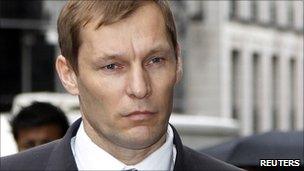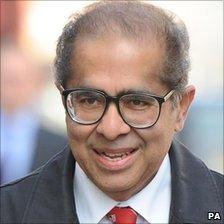Ian Tominson: Inquest jury's verdict explained
- Published

Pc Simon Harwood: Unlawful killing verdict
Two simple questions lay at the heart of the inquest into the death of Ian Tomlinson: Did he die because he was pushed over by Pc Simon Harwood - and was that push lawful?
In little under half a day, the jury returned a clear verdict against the Metropolitan Police officer, a member of the Territorial Support Group (TSG).
Pc Harwood already faces disciplinary proceedings - but now also waits to hear if he will be prosecuted.
Ian Tomlinson was not one of the thousands of protesters at the G20 summit in London. He had been helping to sell newspapers and was trying to pick his way through closed roads, crowds and police lines near the Bank of England.
What happened next was captured on film by witness Chris La Jaunie, an American fund manager who only later realised the significance of his footage.
His film showed Mr Tomlinson, hands in pockets, walking with his back to the police lines.
Pc Simon Harwood thrusts himself forward and uses his baton to strike at Mr Tomlinson, before pushing him over, with what witnesses said was considerable force.
In his own evidence, Pc Harwood accepted that it had been a "poor push".
Shocked and angry, Mr Tomlinson remonstrated with the officers, but then got up with the help of witnesses and walked away - only to collapse and die shortly afterwards.
Medical evidence

Dr Patel's post-mortem examination said death was due to natural causes
On the day that he died, Ian Tomlinson, 47, was already severely ill because of his alcoholism. It was clear to some of the doctors involved in this case that his drinking could have eventually killed him.
The medical question was whether Pc Harwood's actions hastened Mr Tomlinson's death.
The first post mortem was conducted by Home Office pathologist Dr Freddy Patel.
His conclusion was that Mr Tomlinson, who had been drinking that afternoon, died of natural causes.
It was this finding - and the contradictory findings of two further reports - that led the Crown Prosecution Service to conclude that there was not a reasonable chance of a conviction if Pc Harwood faced trial.
But when it came to the inquest, Dr Patel accepted during cross examination that the push could have caused the death.
In effect, the jury had to weigh the report and admissions of Dr Patel - suspended for four months by the General Medical Council for unrelated failings - with the evidence of six other physicians.
The most important of those was Dr Nat Cary. He conducted a separate examination. He could not carry out tests on bodily fluids, including blood, because Dr Patel had failed to keep them.
Dr Cary told the inquest that Mr Tomlinson's fall had almost certainly caused internal bleeding in his abdomen, probably from damage to his liver.
The blood loss in turn led the 47-year-old to go into cardiac arrest. Another pathologist, Dr Kenneth Shorrock, also said the cause of death was internal bleeding.
The jury accepted this analysis of the evidence. The fall caused the bleed and the bleed led to death. That left the question of whether the push was lawful.
Menezes shooting
Police can legally use reasonable force - but they must personally justify their decision to do so.
At the inquest into the shooting of Jean Charles de Menezes in 2005, the two officers responsible for his death showed they had legal justification to open fire because they honestly believed they were confronting a suicide bomber.
But in the case of Pc Harwood, the jury rejected any claims that he had acted legally.
The TSG officer told the inquest that he understood the law and that he had to personally answer for his actions.
He said that his push had been necessary because Mr Tomlinson was ignoring requests to move. But he also acknowledged that Mr Tomlinson did not pose a threat.
Protest soul searching
Whatever the outcome of this inquest, the aftermath of the G20 would have continued to reverberate throughout the policing world.
Since the 2009 protests, there has been a great deal of soul searching by senior officers about how to best police massive demonstrations - particularly dynamic events that do not stick to an agreed route.
Metropolitan Police Commissioner Sir Paul Stephenson ordered all officers to make their numbers visible in the wake of claims at the G20 that some were hiding their identities.
More recently, the High Court has ruled that the Met acted unlawfully in containing the peaceful "Climate Camp" element of the G20 demonstrations.
Her Majesty's Inspectorate of Constabulary separately criticised the Met's overall G20 plans as inadequate. But the watchdog has also questioned whether forces are capable of dealing with protests in the age of social media.
But despite pressure to take a more softly-softly approach, the Metropolitan Police found itself on the back foot again last November when students stormed the Conservative Party's headquarters in Millbank, central London.
Weeks later, they were criticised again for deploying tougher tactics, including hours of containment, as students and other anti-cuts activists organised demonstrations across the city.
Whatever now happens to Pc Harwood, the debate over how to manage protests remains one of the biggest challenges for the UK's chief constables.
- Published28 April 2011
- Published5 August 2013